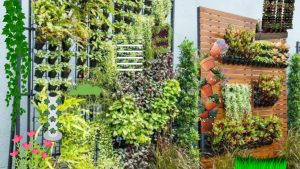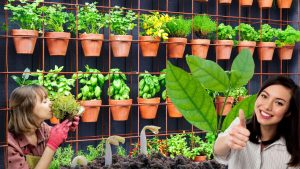How to create a vertical garden? A Complete Guide

Vertical gardening is a fantastic way to maximize your growing space, whether you’re dealing with a small backyard, a patio, or even a balcony. Not only does it allow you to grow more plants in less space, but it can also make harvesting easier and improve plant health. In this article, I’ll walk you through how to create a vertical gardening from scratch, the benefits it brings, and some DIY ideas to keep costs down. Plus, we’ll explore the types of plants that grow well vertically and answer some common questions about vertical gardening. By the end, you’ll be ready to start your very own vertical garden.
What is Vertical Gardening?
Vertical gardening involves growing plants upward rather than letting them sprawl across the ground. By using structures like trellises, walls, or frames, plants such as fruits, vegetables, and herbs can climb and thrive vertically. This technique not only saves ground space but also encourages healthier plant growth by keeping leaves and fruits off the soil, reducing the risk of pests and diseases.
Whether you have a tiny urban gardening or a sprawling backyard, a vertical gardening can fit almost any space. It’s a solution that works for people with limited room or those who just want a more organized and beautiful gardening.

Benefits of Vertical Gardening
- Maximizes Space
Vertical gardening allows you to grow more in less space. Instead of dedicating 20 square feet to a sprawling squash plant, you can grow it up a trellis and free up valuable room for other crops. - Easier Harvesting
Harvesting vegetables from a vertical gardening is much more convenient. You can pick fruits and vegetables at eye level, eliminating the need to bend, kneel, or sift through dense foliage. This saves your back and knees, making gardening more enjoyable and less labor-intensive. - Healthier Plants
Growing plants vertically improves air circulation around them, reducing moisture on the leaves and fruits. This helps prevent fungal infections, blight, and pest attacks. Additionally, fruits and vegetables are kept off the ground, where they’re less likely to rot or be eaten by critters. - Beautiful Garden Design
Vertical gardens add an aesthetic element to your space. The vertical lines and structures provide a unique design, creating a visually appealing garden that’s also functional. Arched trellises, for instance, can turn a simple garden into a magical outdoor space.
How to Create a Vertical Garden
Now that we’ve covered the benefits, let’s dive into the steps to create your own vertical gardening.
Step 1: Choose Your Location
The first step is determining where your vertical garden will go. Choose a location that gets plenty of sunlight, as most plants thrive with at least 6–8 hours of sunlight a day. If you’re growing plants that prefer shade, adjust accordingly.
Step 2: Select Your Structure
There are many structures you can use to grow your plants vertically. Here are a few options, ranging from affordable DIY solutions to more polished setups:
- Trellises
Trellises are perfect for climbing plants like cucumbers, beans, and peas. You can purchase pre-made trellises or build your own using inexpensive materials such as T-posts and cattle panels. For example, you can create an arched trellis by bending a cattle panel into shape and securing it with T-posts. - Welded Wire
Welded wire is a cost-effective option. You can buy a 50-foot roll of welded wire for around $35, enough to support multiple plants. Simply cut the wire to your desired size and attach it to a sturdy frame or support system. - Cattle Panels
These are strong and durable, making them perfect for larger plants like tomatoes or squashes. You can use cattle panels to create beautiful arched trellises, providing both functionality and aesthetic appeal. - Recycled Materials
If you’re looking for budget-friendly options, consider using recycled materials like old window frames, bed frames, or even fencing. These can be repurposed to create a sturdy vertical structure. Get creative with what you have!
Step 3: Prepare the Soil
Before planting, ensure that your soil is rich in nutrients and well-drained. Vertical gardening still rely on good-quality soil, so consider using raised garden beds or containers with organic compost or potting soil.
If you’re growing directly in the ground, amend the soil with compost or manure to boost its fertility. This step is crucial because vertical gardens often grow high-yield crops that require nutrient-rich environments to thrive.
Step 4: Choose Your Plants
Many plants thrive in vertical gardens, and it’s essential to choose ones that will benefit from the upward growth pattern. Some excellent options include:
- Climbing Beans and Peas: Naturally suited for vertical growth, these plants will climb trellises with ease and produce a bountiful harvest.
- Cucumbers: Growing cucumbers vertically allows them to avoid pests and keeps the fruits off the ground, reducing rot.
- Tomatoes: Vining varieties of tomatoes, such as cherry tomatoes, are perfect for vertical gardening.
- Melons and Squash: While these plants can get heavy, using mesh or slings to support the fruit will keep them off the ground and healthy.
- Herbs: Basil, mint, and thyme are great choices for vertical planters or hanging baskets.
Step 5: Plant and Train Your Plants
Once you’ve selected your plants, it’s time to plant them. Place your climbing plants at the base of the trellis or structure, allowing enough space for growth. As they grow, gently guide the vines to attach to the support system. You may need to tie the vines initially with soft gardening ties to encourage upward growth.
For heavier plants like melons, use mesh bags or slings to support the fruits as they develop. This prevents them from pulling the plant down and ensures they ripen without damage.

Step 6: Maintain Your Vertical Garden
Vertical gardens generally require less maintenance than traditional ground gardens, but they still need regular care. Here are some key tips for keeping your vertical gardening healthy:
- Watering: Vertical gardens can dry out faster than ground gardens, so ensure consistent watering, especially in hotter climates. Drip irrigation systems work well to evenly distribute water.
- Pruning: Regularly prune your plants to keep them from becoming overcrowded. Removing dead or yellowing leaves also promotes air circulation and reduces disease risks.
- Fertilizing: Fertilize your plants every few weeks with a balanced organic fertilizer to support their growth and fruit production.
Affordable Vertical Gardening Ideas
Vertical gardening doesn’t have to break the bank. Here are some cost-effective ways to create a vertical garden:
- T-posts and Welded Wire: This combination is inexpensive and widely available. Use T-posts for support and welded wire to create trellises.
- Cattle Panels: Build large arched trellises with cattle panels for around $30, perfect for supporting heavier plants like squashes and melons.
- Recycled Fencing or Gates: Repurpose old fencing or gates into vertical trellises for free or at a low cost.
- Clotheslines: Run clotheslines between posts to create a simple support system for climbing plants.
FAQs
What plants grow well in a vertical garden?
Many plants thrive in a vertical gardening, including climbing beans, peas, cucumbers, tomatoes, melons, and herbs like basil and mint. Opt for vining or trailing plants that can easily attach to a support structure.
Do vertical gardens need special soil?
Vertical gardens need the same nutrient-rich soil as traditional gardening. Ensure your soil is well-drained and amended with compost or organic matter to support healthy plant growth.
How often should I water my vertical garden?
Vertical gardens may require more frequent watering, especially during hot, dry weather. Ensure your plants get enough water to prevent them from drying out. Consider installing a drip irrigation system to maintain consistent moisture levels.

Question and Answer Section
Q: Can I grow different plants on the same vertical structure?
A: Yes, you can grow different plants on the same trellis. Just make sure the plants have similar water and light requirements to ensure they thrive together.
Q: How do I support heavy fruits like melons in a vertical garden?
A: You can use mesh bags or slings to support heavy fruits like melons. These prevent the fruits from weighing down the plant or falling off before ripening.
Q: Is vertical gardening suitable for small spaces?
A: Absolutely! Vertical gardening is perfect for small spaces like balconies or patios, as it maximizes space by growing plants upward rather than outward.
Q: Are vertical gardens expensive to set up?
A: Vertical gardens can be set up on a budget. You can use affordable materials like T-posts, welded wire, or even recycled items to create your vertical gardening structure.

One Comment